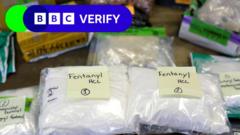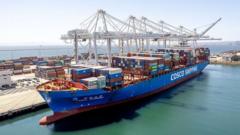The opioid crisis in the United States, predominantly fueled by fentanyl, has drawn ire towards China for supplying precursor chemicals and criticisms toward Mexico and Canada for unsuccessful border enforcement. Amidst rising overdose deaths, the origins and smuggling routes of this deadly synthetic opioid continue to pose significant challenges for US law enforcement agencies.
The Fentanyl Crisis: A Complex Supply Chain Challenges US Authorities

The Fentanyl Crisis: A Complex Supply Chain Challenges US Authorities
Investigating the multifaceted routes through which fentanyl enters the United States, highlighting the roles of China, Mexico, and Canada in the opioid epidemic.
The opioid epidemic in the United States has reached alarming levels, primarily driven by the deadly synthetic drug fentanyl and its complex supply chain. This crisis has led the Trump administration to impose strict tariffs on Chinese imports, blaming China for its role in exporting precursor chemicals essential for fentanyl production. Although Beijing has responded with its own tariffs, the friction over drug trafficking remains unresolved.
Fentanyl is a powerful opioid, medically approved for pain relief since the 1960s. However, its misuse has surged, with the US Centers for Disease Control (CDC) reporting over 74,000 overdose deaths linked to fentanyl in 2023 alone. The potency of this drug is staggering; merely two milligrams can be lethal. The alarming rise in overdose cases is compounded by the drug's clandestine presence in various illicit substances, leaving many unsuspecting users vulnerable.
Recent statistics reveal that the vast majority of fentanyl smuggled into the US comes through Mexico. Since September, US authorities have confiscated 4,500 pounds (or approximately 2,040 kilograms) of fentanyl, with 98% intercepted at the southwestern border. Criminal organizations, notably the Sinaloa Cartel, have been identified by the US Drug Enforcement Administration (DEA) as integral to the manufacturing and distribution of fentanyl across the border.
These cartels utilize diverse smuggling methods, including disguising shipments within legitimate cargo and leveraging sophisticated networks to elude law enforcement. The US has also levied serious accusations against the Mexican government, claiming alleged collusion with these drug enterprises, to which President Sheinbaum has firmly rebuffed.
While China remains the chief provider of chemicals used in fentanyl production, the DEA has begun monitoring India's growing role in this nefarious supply chain. Recent indictments demonstrate that certain companies in India were found supplying necessary chemicals for fentanyl production to both the US and Mexico.
In a related struggle, Canadian authorities have also faced scrutiny for their involvement in the fentanyl crisis. Despite only 0.2% of fentanyl seizures occurring at the US-Canada border, the Canadian financial intelligence agency has noted increasing participation from organized crime in the fentanyl manufacturing process. The Canadian government has responded by committing substantial funding to combat the crisis and bolster border security.
As nations grapple with the ever-evolving dynamics of drug trafficking, it is clear that tackling the fentanyl epidemic requires collaborative and comprehensive strategies addressing the underlying supply chains, cross-border cooperation, and domestic reassessment of drug enforcement practices.





















